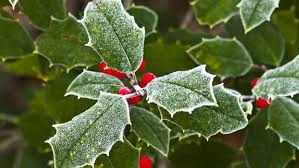Click here for the 'Seeds of Eaden' seed shop
Holly (Ilex) is such a festive plant but it would probably surprise you to know that these are a diverse group of trees and shrubs. They range in height from a couple of feet to 30 metres high and although most are dark green, you can also find purple tints and variegated forms. With so much variation in holly varieties, you’re sure to find one to suit your need.Holly belongs to the Aquifoliaceae family and can be deciduous or evergreen. Holly leaves are often dark green, glossy and oval. Younger plants usually feature spiky leaves, but the leaves of older trees are much more likely to be smooth.
Almost all holly species are dioecious, meaning that male and female flowers occur on different trees. Flowers are white with four petals. Once pollinated by insects, female flowers develop into scarlet berries, which can remain on the tree throughout winter. One male plant is able to pollinate a few female plants. They produce drupes (not berries) that are often red, but may come in shades of white, yellow, purple or black.
Ilex aquifolium (English Holly)
A medium-sized evergreen tree, slow-growing when young, with dark, glossy green, undulate and usually strongly spiny leaves. Small, dull white flowers in spring are followed by bright red berries, on pollinated female plants.
Ilex cornuta (chinese holly)
This evergreen shrubs has dark green leaves with pronounced spines. They tolerate hot temperatures but sustain winter damage in cold zones. The different types of hollies in this group include ‘Burfordii,’ which is one of the most popular cultivars for hedges, and ‘O. Spring,’ a variegated type with irregular bands of yellow on the leaves.
‘Nellie R. Stevens’
This is a cross between hybrid between English holly (Ilex aquifolium and Chinese holly(Ilex cornuta). A parthenogenic cultivar that does not require make and female plants, and so is ideal if you only have room for one plant.
Ilex crenata (Japanese Holly)
Generally softer in texture than Chinese hollies, Ilex crenata comes in a range of shapes and sizes. These hollies don’t do well in areas with hot summers, but they tolerate colder temperatures than the Chinese hollies.
Ilex opaca (American Holly)
These North American natives grow into up to 60 feet tall, and a mature specimen is a landscape treasure. Although these types of hollies are common in woodland settings, they aren’t often used in residential landscapes because they grow very slowly. ‘Old Heavy Berry’ is a vigorous cultivar that bears lots of fruit.
Ilex glabra (Inkberry Holly)
Similar to Japanese hollies, inkberries are distinguished by their black berries. Species types tend to have bare lower branches because they drop their lower leaves, but cultivars such as ‘Nigra’ have good lower leaf retention.
How to grow mistletoe from seed
How to grow Holly from seed
Holly species
How to keep your cut Christmas tree
How to keep your Christmas tree
Christmas trees
Poinsettia care



































